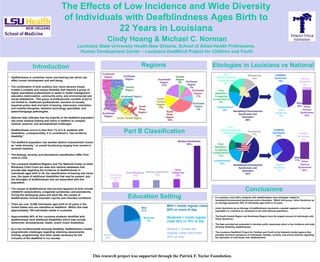Report
Share

Recommended
Recommended
More Related Content
What's hot
What's hot (20)
People With Special Needs: Children With Disability

People With Special Needs: Children With Disability
Nature, characteristics and etiology of mental retardation

Nature, characteristics and etiology of mental retardation
Educational Needs for Children with intellectual and multiple disability

Educational Needs for Children with intellectual and multiple disability
Similar to Hoang%2c Cindy Poster PRINTED
A presentation by the Secretary General of the Kenya Union of Clinical Offciers of disabilty and health at the 3rd Health Sector Development Partner Forum.Disability and health kenya union of clinical officers presentation at the ...

Disability and health kenya union of clinical officers presentation at the ...Emmanuel Mosoti Machani
Similar to Hoang%2c Cindy Poster PRINTED (20)
1 DQ 1When a baby is born, one of the first concerns is thei.docx

1 DQ 1When a baby is born, one of the first concerns is thei.docx
Modyul 2 sub modyul 2.2 paksa 4 sesyon 3 pwds presentationrevised

Modyul 2 sub modyul 2.2 paksa 4 sesyon 3 pwds presentationrevised
1_Chapter_1_Understanding_Disability_&_Vulnerability_FINAL.ppt

1_Chapter_1_Understanding_Disability_&_Vulnerability_FINAL.ppt
Educating Patients Understanding Barriers,Learning Styles, .docx

Educating Patients Understanding Barriers,Learning Styles, .docx
Educating Patients Understanding Barriers,Learning Styles, .docx

Educating Patients Understanding Barriers,Learning Styles, .docx
Mentally Retarded Children and Deficits in Daily Living Skills: Case Study of...

Mentally Retarded Children and Deficits in Daily Living Skills: Case Study of...
Disability and health kenya union of clinical officers presentation at the ...

Disability and health kenya union of clinical officers presentation at the ...
Hoang%2c Cindy Poster PRINTED
- 1. The Effects of Low Incidence and Wide Diversity of Individuals with Deafblindness Ages Birth to 22 Years in Louisiana Cindy Hoang & Michael C. Norman Louisiana State University Health-New Orleans, School of Allied Health Professions, Human Development Center – Louisiana Deafblind Project for Children and Youth • Deafblindness is combined vision and hearing loss which can affect human development and well-being. • The combination of both auditory and vision sensory losses creates a complex and unique disability that requires a group of highly specialized professionals to assist in health management, education matriculation, community entry, and environmental and social adaptations. This group of professionals consists of but is not limited to: healthcare professionals, teachers of visually impaired and/or deaf and hard of hearing, interveners, orientation and mobility therapists, assistive technology specialists, and speech/language pathologists. • National data indicates that the majority of the deafblind population has some residual hearing and vision in addition to complex medical, physical, and developmental challenges. • Deafblindness occurs in less than 1% of U.S. students with disabilities; consequentially, it is considered a “low incidence disability.” • The deafblind population has another distinct characteristic known as “wide diversity,” or overall functioning ranging from normal to severely impaired. • The etiology, severity, and educational classification differ from child to child. • The Louisiana Deafblind Registry and The National Center on Deaf- Blindness Child Count are state and national databases that provide data regarding the incidence of deafblindness in individuals ages birth to 22, the classification of hearing and vision loss, the types of additional disabilities that may be present, and the etiologies of deafblindness that are associated with this population. • The causes of deafblindness that become apparent at birth include childbirth complications, congenital syndromes, and prematurity. During the developing years and adult life, the causes of deafblindness include traumatic injuries and inherited conditions. • There are over 10,000 individuals ages birth to 22 years in the United States who are classified as deafblind. Within this total, approximately 105 individuals reside in Louisiana. • Approximately 90% of the Louisiana students identified with deafblindness have additional disabilities which may include behavioral, developmental, health, and/or motor disabilities. • As a low incidence/wide diversity disability, deafblindness creates programmatic challenges regarding obtaining assessments, training, programming, and other needs necessary for full inclusion of the deafblind in our society. Part B Classification Education Setting Regions Conclusions Etiologies in Louisiana vs National • In Louisiana, most (40%) students with deafblindness have etiologies related to hereditary/chromosomal syndromes and/or disorders. Within this group, Usher Syndrome as an etiology represents 39% of individuals ages birth to 22 years. • Usher Syndrome as an etiology of deafblindness represents a greater segment of the total population in Louisiana as compared to the total national population. • The South Central Region and Southwest Region have the largest amount of individuals with Usher Syndrome. • The data provided are presented to develop public awareness about a low incidence and wide diversity disability, deafblindness. • The Louisiana Deafblind Project for Children and Youth is the federally funded agency that provides technical assistance to individuals, families, schools, and school districts regarding the education of individuals with deafblindness. Introduction . This research project was supported through the Patrick F. Taylor Foundation. Pre- Natal/Congenital Complications 15% Post- Natal/Non- Congenital Complications 9% Undetermined 20% Hereditary/Chromosomal Syndromes and Disorders 40% Prematurity 16% Other 42% CHARGE Syndrome 19% Usher Syndrome 39% Stickler Syndrome 6% Other Various Syndromes 35% Post- Natal/Non- Congenital Complications 13% Undetermined 18% Hereditary/Chromosomal Syndromes and Disorders 43% Pre- Natal/Congenital Complications 15% Prematurity 11% Other 71% CHARGE Syndrome 22% Usher Syndrome 7% Stickler Syndrome 3% Other Various Syndromes 68% Intellectual Disability 8% Deaf-Blindness 11% Hearing Impairment 11% Other Categories 12% Multiple Disabilities 59% 0 5 10 15 20 25 30 35 40 45 Mild 21% Severe 76% Moderate 3% Mild = Inside regular class 80% or more of day Moderate = Inside regular class 40% to 79% of day Severe = Inside the regular class less than 40% of day